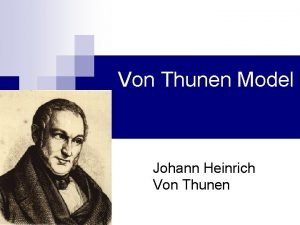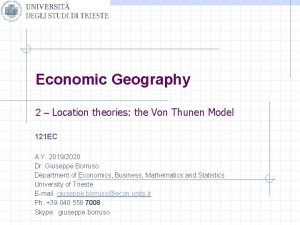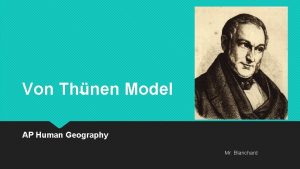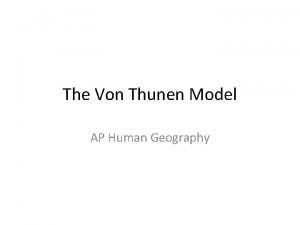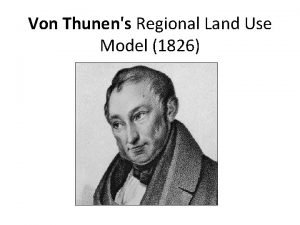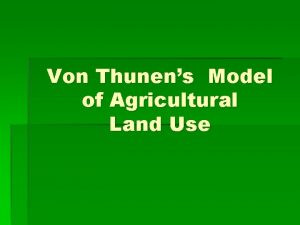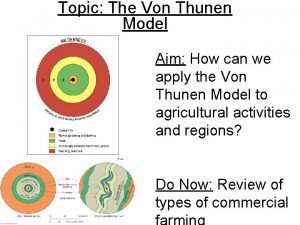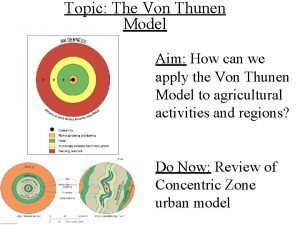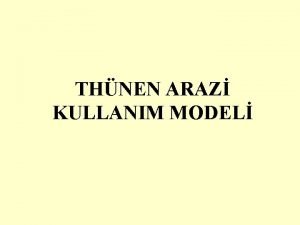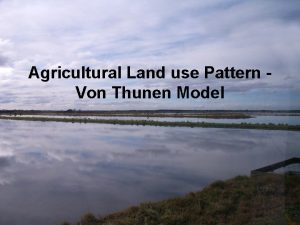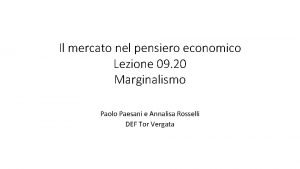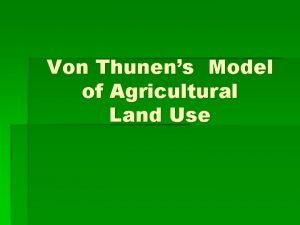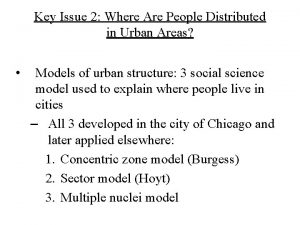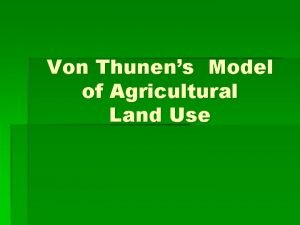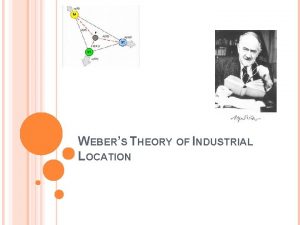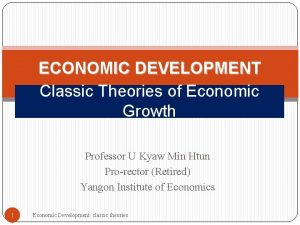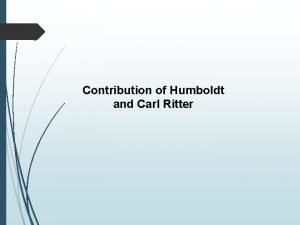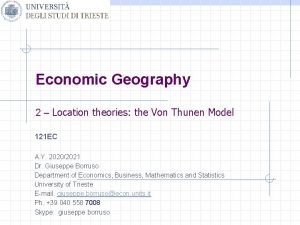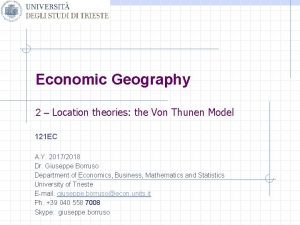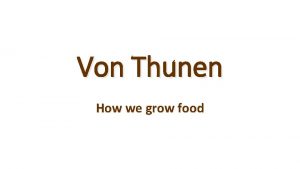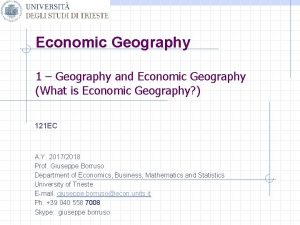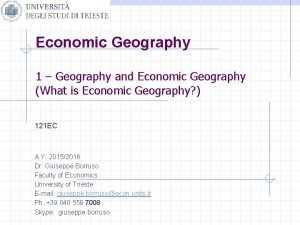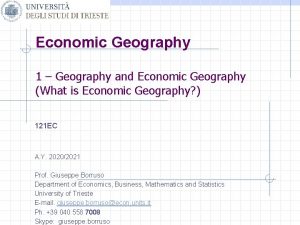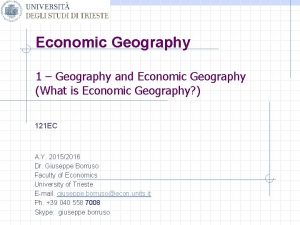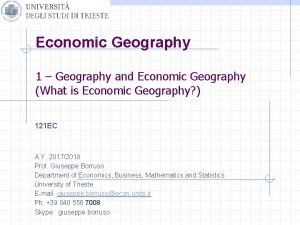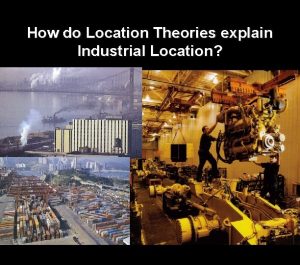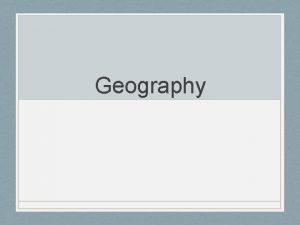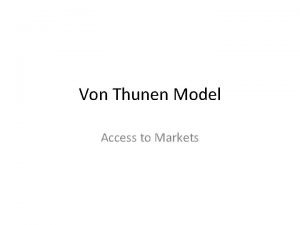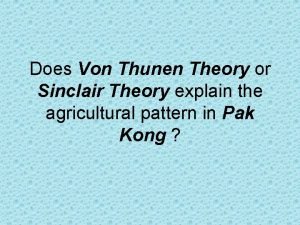Economic Geography 2 Location theories the Von Thunen



























- Slides: 27

Economic Geography 2 – Location theories: the Von Thunen Model 121 EC A. Y. 2018/2019 Dr. Giuseppe Borruso Department of Economics, Business, Mathematics and Statistics University of Trieste E mail. giuseppe. borruso@econ. units. it Ph. +39 040 558 7008 Skype: giuseppe. borruso

Learning Objectives w In this lesson we will: n n n Revise the importance of models in economic geography Introduce the simplifying assumptions and hypothesis of most location models Describe the Von Thunen model of agricultural organization

Topics 1. Location theories: 1. 2. 3. 4. Spatial organization of Agriculture Market and location of services The location of industries Human settlements => 2. Retail and transport Geography 3. Geodemographics – GIS & Retail Geography

Replay Geographical models and the study of human space (1/2) w Model = an idealized representation of the real world, built to present some properties (social and economical phenomena). w Models become necessary as reality is complex

Replay Geographical models and the study of human space (2/2) w Economic geography contributed to implementing theories based on the use w w w w of the geographical space and on criteria that orientate the location of human settlements and production activities => how humans transform their environment to satisfy their needs In time Geography and Economics reduced space to its essentials, by which analyse to understand the dynamics of an organized system (settlements or production). Economic geographers simulated reality from empirical observations in order to understand explain the complexity of the geographical space. The simplification become a geographical economical model, based on inductive research (top down) rather than the micro and macro approach proper of economics. First geographical economical models and the economical ones share schematic and simplified representations of reality and the reduced number of elements of reality (new geography and quantitative geography). A model as a simplified description of reality to represent social and / or economical phenomena. The models to be examined will focus on the localisation of : n n Agriculture Industry Services (including transport) Human settlements

Rent: Ricardo vs Von Thunen David Ricardo w differences in productivity between two pieces of land, using same capital and technology w von Thünen w importance of differences in distance to markets and thus of transportation costs

David Ricardo on Economic Rent w Economic rent on land is the value of the difference in productivity w w between a given piece of land the poorest piece of land (or the land most distant from the market) producing the same goods (bushels of wheat) under the same conditions (of labour, capital, technology, climate) Essence of argument: wide differences in production and marketing costs between the best and worst lands called into production to feed a given population Productivity of agricultural land defined by: n n n the natural fertility of the soil: as utilized by given technology and stock of capital the distance from the market in which the grains (or other agricultural goods) are sold the productivity differences involve the costs of both producing and marketing the grains in a given market.

Location theories w Different models adapted to different kinds of activities w Similar starting points w From simplified models to more complex ones w Hypothesis – generally a common starting point for the different models: n n n Homogeneity and isotropy of space (no differences in morphology of space; no transport asymmetries; ecc. ) Fertility of land is homogeneous – if a rent exists, it depends on transport costs based on distance Perfect competition (same price throughout the market; freedom of movements of factors of production; no transport costs)

Location theories (Agriculture) Von Thunen (1/2) w John Heinrich Von Thunen (Jever, Oldemburg – East Germany 1783 - 1850): w agronomer number of important and original anticipations of modern economic theory: n n n concepts of economic rent, diminishing returns, opportunity costs, the marginal productivity theory of wages a pioneer in the economic theory of location w Ricardo and Von Thunen recognized that differences in the cost of producing w w agricultural products result from utilization of land of different quality and location Ricardo focused on differ ences in soil fertility Von Thunen focused in differences in land location n recognized that those products that are bulky in rela tion to value are more costly to transport than those that are less so and that some farm products cannot stand a long period in transit because of their perishability w Problem: devise the best (most profitable) system of land utilization

Location theories (Agriculture) Von Thunen (2/2) w w John Heinrich Von Thunen (Jever, Oldemburg – East Germany 1783 - 1850): agronomer 1826: The isolated state n w w w n Effects of a unique urban central market on the distribution of cultivations in a homogeneous space accessibility to the market (town) can create a complete system of agricultural land use. Assumptions: n The city is located centrally within an "Isolated State" which is self sufficient and has no external influences. n A large town (market) is situated in the center of a fertile plain that has neither canals nor navigable rivers n Means of transport is a horse drawn wagon or a similar n All land within the plain is of equal fertility, and there are no other comparative advantages of production between plots n At a considerable distance from the city, the plain ends in an uncultivated wilderness n “isotropic plain” no site differences, no transportation barriers or roads n “Isolated State” i. e. no trade with other communities n all farmers receive the same marketplace price for the same crop at a given time n all farmers seek to maximize profits, and they all have perfect information n there is only one form of transportation (which is also uniform across the plain) n the cost of transportation is directly proportional to distance (e. g. $x per mile) => Von Thunen hypothesized that a pattern of rings around the city would develop. Concentric rings in a circular space with the market city at centre; Rings are organized according to the production techniques of the time; Positional rent articulates a physically uniform space in zones with specific land uses, corresponding to computable distances from the central place.

Von Thunen’s model of land use The isolated state Central market Dairy & vegetables forestry Intensive crop rotation Arable and pastures Three-field crop rotation system Extensive stock grazing

Von Thunen’s model of land use w There are five rings of agricultural activity surrounding the city. w Dairying occur in the ring closest to the city. n Since vegetables, fruit, milk and other dairy products must get to market quickly, they would be produced close to the city (no refrigerated oxcarts!) w Timber and firewood would be produced for fuel and building materials in the second zone. n Before industrialization (and coal power), wood was a very important fuel for heating and cooking. Wood is very heavy and difficult to transport so it is located as close to the city as possible. w Intensive farming is located in the third zone w The fourth zone consists of extensive fields crops such as grains for bread. n Since grains last longer than dairy products and are much lighter than fuel, reducing transport costs, they can be located further from the city. w The fifth zone occupies Three field crop rotation system w Ranching is located in the final ring surrounding the central city. n Animals can be raised far from the city because they are self transporting. Animals can walk to the central city for sale or for butchering. w Beyond the fourth ring lies the unoccupied wilderness, which is too great a distance from the central city for any type of agricultural product.

Von Thunen’s model of land use w Positional rent articulates a physically uniform space in zones with specific land uses, corresponding to computable distances from the central place. w Land uses given by w Where n n n Rp = monetary rent of a unit surface in a given point p of the space [location rent per unit of land]; R = physical rent of the same unit surface [yield per unit of rent]; p = market price for each unit/weight of product at the marketplace [market price per unit of commodity]; c = production cost at the location of growing [production cost per unit of commodity]; t = transport cost per unit of distance between the growing location and the market [transport rate per unit of distance]; d = distance between the point (growing location) from the market w The function becomes a line: y = a - bx n With different parameters for each production in space. Zones derive from the crossing of different functions n depending on a set of transport costs Ritid n

Von Thunen’s model of land use Transport cost per unit Transport Costs ta tb tc td distance

Von Thunen’s model of land use R A the rent function a Rent a: colture a b: colture b Rb c: colture c Rc Rd b a 5 10 distance c R p c t d 0 a 60 2. 000 1. 000 200 5 b 50 3. 000 2. 200 80 10 c 100 1. 500 1. 200 20 15 d 50 2. 000 1. 600 50 8 => D 1 = 2, 5; D 2 = 5


Von Thunen’s model of land use co nd ar ym ar ke t Modified conditions Se The isolated state Central market River dairy & vegetables forestry Intensive crop rotation Arable and pastures Three-field crop rotation system Extensive stock grazing

Von Thunen’s model of land use applied to mainland USA Forest Wheat Dairy Forest Beef Cattle and Sheep Wheat Corn and Soybeans Vegetables Beef Cattle and Sheep Specialty Crops Cotton and Tobacco Dairy Vegetables Corn and Soybeans Cotton and Tobacco Assumptions 1. New York City the only market 2. Crops ranked by rent paying ability 3. No terrain or climatic variation A Assumptions 1. New York City the only market 2. Crops ranked by rent paying ability 3. No terrain variation 4. Climatic variation considered Specialty Crops B

Von Thunen’s model: critiques and limits w In explaining agricultural patterns near urban areas, Von w w Thünen's theory is generally applicable where the primary force determining the pattern is transport cost to the market. => the pattern of agricultural land use is one of decreasing intensity with distance from the city. Von Thünen's theory still applies in underdeveloped parts of the world, but no more valid in developed areas. In many advanced industrialized parts of the world, the basic forces determining agricultural land use near urban areas are associated with urban expansion. Where these forces are in operation, the agricultural pattern quite often is one of increasing intensity with distance from the city, quite the reverse of the pattern generalized by Von Thünen's theory. SINCLAIR R. , VON THÜNEN AND URBAN SPRAWL, Annals of the Association of American Geographers Vol 57 Issue 1, pages 72– 87, March 1967

Von Thunen’s model: critiques and limits w Why rent curves with negative slopes? w Sinclair hypothesizes an increase in land use values moving out from an urban centre Rent Rx Rent Rby Y X Rby Y Rz Z distance 5 10 SINCLAIR R. , VON THÜNEN AND URBAN SPRAWL, Annals of the Association of American Geographers Vol 57 Issue 1, pages 72– 87, March 1967

Von Thunen’s model: Sinclair’s model w metropolitan expansion is perceived as a w w w w displacement threat investments rise with distance from the frontier to the outer edge four types of farming; fifth is a wider regional speciality far from the city (i) urban farming (small producing units: poultry keeping, greenhouses, mushroom raising, and other building oriented uses) (ii) vacant and temporary grazing, (empty spaces to be sold for speculation or grazing only under short term leases) (iii) transitory field crop and grazing (little investment beyond the short term) (iv) dairying and field crop farming (farmers begin shifting towards more extensive agriculture). (v) specialised feed grain livestock or Corn Belt agriculture http: //www. yourarticlelibrary. com/wp-content/uploads/2014/02/clip_image 028_thumb. jpg

Von Thunen Rent and the city w From the isolated state…. w …to the bid rent theory applied to urban areas

The bid-rent (I) . . . a step forward w Pattern of land uses depend on a variety of settlements’ decisions w Decisions guided by economic process operating within the system. The distribution of urban areas’ use represent a visual and structured phenomenon. w Basic aspects: n n n Each activity derives utility from every site of the urban area; Utility is measured by the rent an activity is willing to pay for the use; Among the differents from the utility of the site, the maximum one will determine the market value w The location rent curve can be regarded as a “bid-rent curve” (Alonso, 1960), because it gives an indication of how much farmers would be prepared to pay for a unit of land at varying distance from the market.

Bid rent and land use. . . a step forward 2 – Overlay of rents 1 – bid rent lines rent A- Retail B- Industry and retail C - Apartments D – Detached houses City borders Distance

. . . a step forward Bid-rent Area A: commercial land use Area B: industrial land use B Area C: residential land use C B C Curva AA’: commercial activities’ rent Curva BB’: industrial activities rent Curva CC’: residential ativities rent C’ A P A’ Q B’ distance

Variations to bid-rent theory. . . a step forward rent A – CBD B – Commerce / industry C – residential high– medium density D – sub-centres E – Suburbia A B C D E

Land use value for activity sector according to the distance from the CBD Land use value . . . a step forward Retail Residential (several components fa Residential (single families) Distance from the centre
 Von thunen 1826
Von thunen 1826 Von thunen theory of agricultural location
Von thunen theory of agricultural location Criticism of von thunen model
Criticism of von thunen model Von thunen’s model definition ap human geography
Von thunen’s model definition ap human geography Von thunen model definition
Von thunen model definition Von thunen 1826
Von thunen 1826 Six assumptions of von thunen model
Six assumptions of von thunen model Con thunen model
Con thunen model Von thunen model rings explained
Von thunen model rings explained The von thünen model
The von thünen model Teori von thunen
Teori von thunen Sinclair model of agriculture
Sinclair model of agriculture Modello di von thunen
Modello di von thunen Von thunen’s model
Von thunen’s model Concentric zone model
Concentric zone model Thunens model
Thunens model Webers model
Webers model Hollis chenery
Hollis chenery Wind von backbord weicht wind von steuerbord
Wind von backbord weicht wind von steuerbord Erasmus von rotterdam beeinflusst von
Erasmus von rotterdam beeinflusst von Rimland theroy
Rimland theroy A cross country skier moves from location a to location b
A cross country skier moves from location a to location b Location planning and analysis summary
Location planning and analysis summary Where is israel on the economic continuum
Where is israel on the economic continuum Economic growth vs economic development
Economic growth vs economic development Prof. meier and baldwin
Prof. meier and baldwin Economic systems lesson 2 our economic choices
Economic systems lesson 2 our economic choices Alexander von humboldt and carl ritter
Alexander von humboldt and carl ritter
